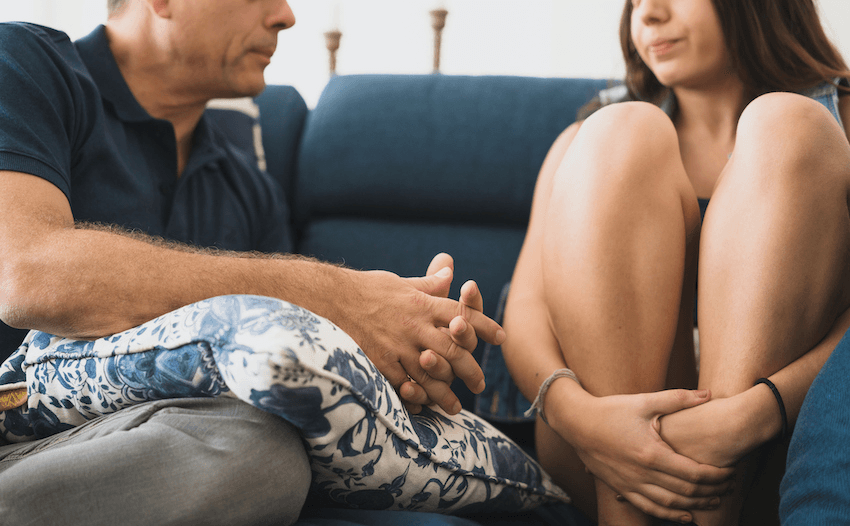In recent research on teens’ use of pornography, one message came through loud and clear: they’re keen to talk. But it’s parents who have to start the conversation, writes the Classification Office’s Kate Whitaker.
Figures recently released by the free pornography site Pornhub show numbers spiking during the Covid-19 lockdown. While it’s natural that people with more free time watch more porn, it’s also natural that this kind of news causes many parents and whānau to worry.
The reality is, lockdown is challenging and being online can be a lifesaver. We can work, connect, watch shows and entertain the kids. Still, some parents likely feel concerned about the extra time their children, especially their teens, are spending in front of screens – and the nature of the content they’re viewing.
Sometimes that concern results in conversations that spiral into arguments. And right now, confrontation in a confined space is the last thing we need! Parents can feel ill equipped to have difficult conversations, and one of the most difficult conversations is about online porn.
It’s true that people are watching more sites like Pornhub. In theory it’s a site for adults, but many young people are using it. Classification Office research in 2018 showed that by the age of 17, 75% of young people have seen porn, and one in four have seen it by age 12.
Despite those stats, our research also showed that the likelihood of a young person having had a conversation with an adult about pornography is extremely low. This makes sense, as a lot of us feel awkward talking about sex, let alone porn. And who can blame us, given that open, honest conversation on difficult topics was not something that was modelled by our own parents and whānau?
This week the Classification Office released the final part of its youth-focused research series into pornography. We talked with over 50 young people across the country about their views on porn, and what they need from adults in order to have healthy constructive conversations.
The majority hadn’t talked to an adult about porn before and we were impressed with how clear and thoughtful they were about what would help them. The key lesson was that we need to talk. Young people see porn as a normal part of growing up and even if they don’t watch it themselves, they expect that others their age do, or have at the very least seen it. And yet no one is talking about it. If they are, it’s as a joke with their mates, not a conversation guided by the trusted adults in their lives.
It’s not an easy conversation to have and it needs trust on both sides. Be honest about how embarrassed you are. Young people get it; they feel it too. It shows you’re human and that you care enough to have the difficult conversations even if they make you uncomfortable.
And when we do start talking, we need to change how we discuss pornography. Saying “Don’t watch porn, it’s bad” or “If you watch porn you could act out what you see and harm someone else” doesn’t really help. While this framing might come from a place of care and concern, it is likely to kill the conversation. It can also make young people feel guilty or ashamed.
What they really need from us is to navigate the conversation in an open way that shows we respect their opinions, and in turn attempts to remove the taboos around discussions of sex.
Remember, watching porn doesn’t mean that all teens’ prior learning about sex, relationships and how to treat each other goes out the window. The overwhelming majority of the young people we interviewed knew that ‘porn sex’ was different to real sex, that these were actors, and that porn didn’t model safe sex or consent.
Asking a young person what they think about porn not only shows that you value their opinions but also enables them to think critically about the messages that exist in porn. While some young people see porn as a way to learn about their sexuality or think it’s simply a good masturbation aid, this new research shows that they generally share the same concerns as many of us about pornography. They see its harms and are worried about other young people who might use it to learn about sex.
Young people we spoke to also felt that the gendered way porn is talked about needed to change. Research shows that while boys are more likely to watch porn, girls and boys watch it for the same reasons. Girls felt frustrated by the double standard that expects only boys to look at porn, supporting the gendered narrative that it’s OK for boys to be sexual but not girls. It is important that this double standard isn’t reflected in the conversations that we have about porn. We need to talk with our kids, regardless of gender, about how porn makes them feel and the expectations it creates around body image and consent.
There is no one size fits all approach, but we should listen to the young people in our lives, avoid judgements and keep our assumptions in check. This doesn’t mean that you have to change your values. Instead, explain why they are important to you in an empathetic and caring way.
This isn’t a one-off conversation and if you don’t get it quite right the first time there’s always tomorrow to give it another try. When asked how they wanted adults to respond when talking about pornography one young person simply said “With compassion, understanding and a source of information.” I think that’s a great place to start.
To help we have created resources including videos and guides. Find them here.

